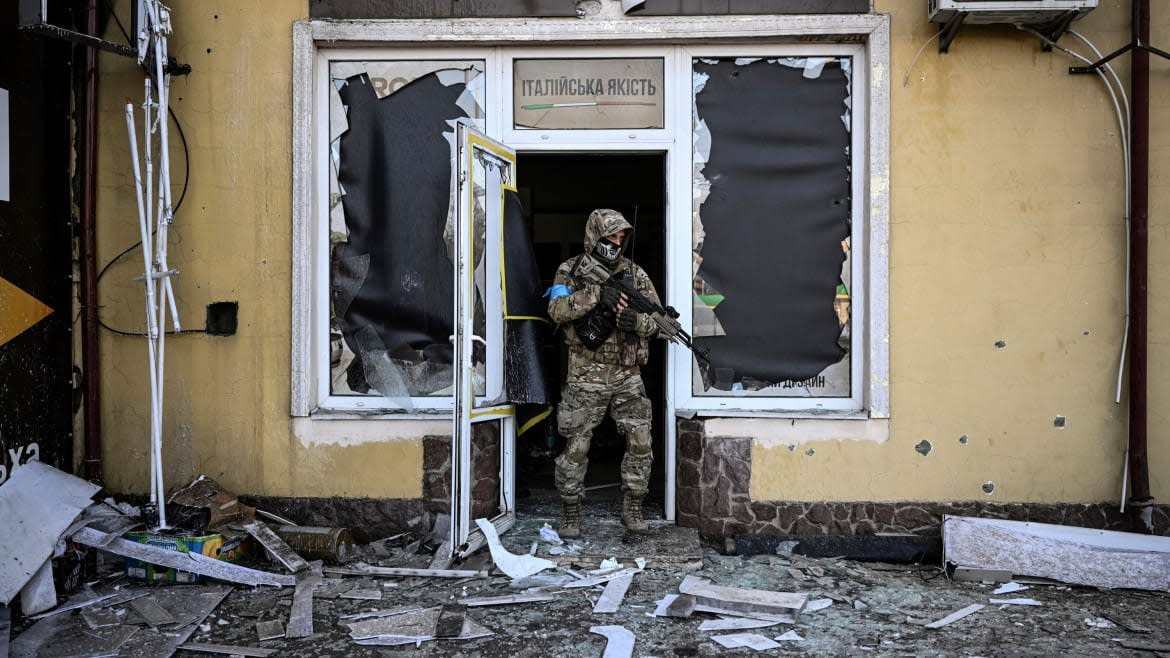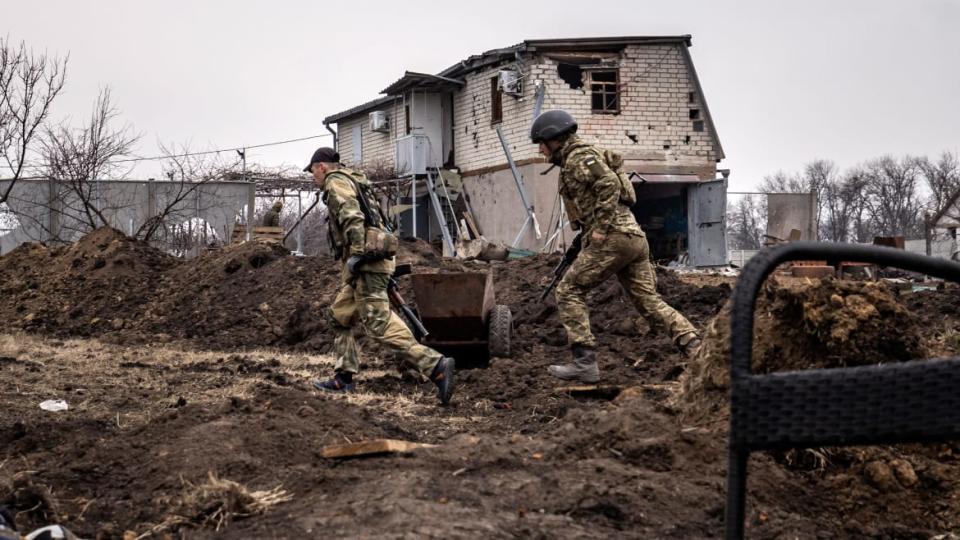Street-Fighting Insurgency Gives Ukrainians a Slight Edge

On March 25, Colonel General Sergei Rudskoi, the deputy chief of staff for the Russian Army, announced a startling shift in Moscow’s strategy. Instead of continuing its drive on Kyiv, the capital, with a view to toppling the government of Volodymyr Zelensky and establishing control over all of Ukraine east of the Dnieper River, the new objective is to “liberate” the entire Donbas region in the southeast of the country. In 2014 and 2015, Russian-backed separatist forces bit off two substantial pieces of Ukrainian real estate in the Donbas, and established two “people’s republics” run by Russian sycophants. It also annexed the Crimea.
Although the announcement was initially viewed with skepticism by Western intelligence and military authorities, it now seems clear that Russian forces in the northern front around Kyiv are indeed withdrawing, with a view to regrouping and redeploying to the southeast, even as the senior leadership in Moscow tries to address their forces’ myriad problems with logistics and command and control.
You Won’t Believe the Horror Left Behind Once Russian Invaders Are Chased Out of Town
Unless a cease-fire and a negotiated settlement can be reached soon—a development that seems extremely remote at this point—the war that lies ahead is certain to be dominated by a series of overlapping, vicious, and horrifically destructive battles not only around but inside the narrow, winding streets of Ukraine’s major cities. Urban military operations in Ukraine will be of two types, predominantly: conventional combined arms assaults by Russian forces against well dug-in Ukrainian defenders, and a prolonged Ukrainian insurgency against Russian forces once they have managed to expel their Ukrainian defenders from urban centers.
The first major city to fall to the Russians will surely be Mariupol, a strategically vital port city on the Sea of Azov. Should the Russians take it, they will be well on their way to securing a land bridge between Russian-controlled Crimea and the Donbas region. Mariupol has been pounded to bits for more than four weeks. According to the city’s mayor, Vadym Boychenko, more than 90 percent of its 2,600 residential buildings have been damaged or destroyed, and more than 5,000 people killed. The Russians already control many neighborhoods in the city’s outskirts, and have effectively cordoned off the city, where about 150,000 civilians remain without water or power. According to the mayor, citizens and soldiers alike are using untreated sewerage water just to survive. Jack Watling, a British expert on land warfare, told The New York Times recently that he did not expect the defenders to hold on for much longer, but that an insurgency would continue against the Russians indefinitely once they took over.
Among Western armies, including the American army, fighting within urban, built-up areas—as opposed to fighting for control of cities from open country—was a rarity up to World War II, which featured the mother of all urban battles, Stalingrad, as well as major street-by-street brawls in Aachen, Berlin, and Manila among other places. According to Anthony King, a leading expert on the subject and the author of Urban Warfare in the Twenty-First Century, smaller, largely professional armies and the rapid pace of urbanization of the world’s population help explain why so many crucial battles since the end of the Cold War are fought inside cities like Beirut, Mogadishu, Fallujah, Baghdad, and Mosul. In Mosul in 2017-2018, it took 90,000 Iraqi troops supported by about 1,000 U.S. Special Forces troops and air power nine months to wrest the city back from its 10,000 diehard Islamic State defenders. The IS fighters deployed no less than 482 vehicular suicide attacks. By the end of the battle, the entire city was in ruins.

Ukrainian servicemen run at the front line east of Kharkiv on March 31, 2022.
As Mosul and the other battles mentioned above attest, urban warfare is extremely challenging for military planners as well as commanders. It is also horrifically lethal and destructive. The urban battlefield, with literally thousands of concrete and steel structures, complex transport and infrastructure systems, and large populations of civilians whose presence, in theory at least, is supposed to lead to the careful restraint and calibration of the use of deadly force, presents a host of dilemmas and difficulties for the adversaries. “Cities are like sponges that soak up troops and resources,” explains John Spencer, an expert on the subject at West Point Military Academy, and former infantryman.
Urban battle-spaces invariably feature scores of close-in, savage infantry fights over tiny pieces of real estate—single fortified positions, individual street blocks, and neighborhoods—and is carried out within buildings, underground, in the streets, and in the air. Broadly speaking, urban combat favors the defender, particularly the highly motivated indigenous defender who enjoys the support of the local populace in acquiring intelligence about the attacker. Barry Posen, a renowned strategic studies scholar at M.I.T., gives this granular picture of the grim tactical realities of fighting in cities today:
Buildings provide high levels of protection and concealment for infantry soldiers. Multi-storied buildings, with basements, permit defenders to maneuver in a third dimension. Modern cities also have elaborate sewer systems, and often underground tunnels for transit systems. Thus, defenders may maneuver laterally, entirely out of sight of the attacker. Buildings provide significant obstacles to the movement of heavy equipment, limiting the ability of advanced militaries to exploit fully their superiority in armored warfare. Long fields of fire are scarce, so technological advantages in accurate long-range fire are neutralized. The majority of engagements take place at very close range… Multi-story buildings may also permit defenders to shoot antitank weapons at angles that permit the rounds to penetrate the generally thinner top armor of tanks and infantry fighting vehicles… Open space is scarce, so defenders may even have a good idea where an attacker might attempt a helicopter landing.
Yes, for sure, urban warfare favors the defender, but there should be no illusion that the heavily outgunned and outmanned Ukrainian forces will be able indefinitely to fend off a determined Russian drive to capture their cities.
Every Russian assault into a city is sure to be hideously costly and destructive. Russian forces’ utter disregard for the laws and norms of military operations involving civilian populations essentially guarantee that this will be the case. Over time, however, world opinion is likely to exert considerable political pressure on Moscow to halt, or at least limit, its criminally negligent operational fighting style.
Once the Russians do gain control over key urban centers, they are likely to face one of the best-organized and most highly motivated insurgencies since World War II. As I wrote in another Daily Beast essay recently, the Ukrainian special forces have been training for the last eight years to lead such a campaign. With considerable assistance from the CIA, and NATO advisers, they have developed a national mobilization scheme to wage a protracted insurgency against the Russian invaders. According to Douglas London, a 34-year veteran of the CIA’s clandestine service who has worked in the region, Russia’s military advantage “will diminish as the enemy it fights changes from an organized army to a decentralized, mobile resistance” composed of small units employing guerrilla warfare tactics.
Experts on insurgency warfare generally agree that for an insurgency to succeed, it needs to have strong political support among the local population, an ample pool of motivated recruits, competent leadership, and neighboring allies who can provide ample military and humanitarian support.
The good news is that Ukraine has all four. The bad news is that it could take as long as 10 years to drive the Russians out. But in the end, it seems impossible for Moscow to prevail in any meaningful sense in an insurgency war. The Russians do counterinsurgency even worse than the Americans.
And that is saying something.
Get the Daily Beast's biggest scoops and scandals delivered right to your inbox. Sign up now.
Stay informed and gain unlimited access to the Daily Beast's unmatched reporting. Subscribe now.

